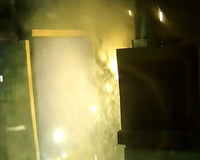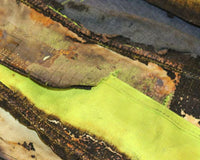Content Library

IEEE 1584 v DGUV-I 203-077

When are Arc Flash Suits Required?
Arc Flash suits are used in situations where electrical systems pose a risk of releasing intense energy through an arc flash event. Commonly utilised by professionals in the electrical, utility, and industrial sectors, arc flash suits are offer multiple levels of protection categorised according to their ability to shield against thermal energy, flames, and other hazardous elements.
In this article, we will explore the attributes of arc flash suits, their applications, intended users, and the distinct categories of protection they provide, highlighting the paramount importance of these suits in ensuring worker safety and mitigating potential workplace hazards.
ELIM & ATPV in Arc Flash Testing
ELIM, which stands for " Energy Limit Value," is a term used in the context of arc flash testing and electrical safety. It represents a conservative approach to determining the protective capabilities of materials and clothing against the hazards of an arc flash event. An arc flash is a sudden release of electrical energy through the air, which can result in intense heat, light, sound, and pressure, potentially causing severe injuries or even fatalities.

Understanding Arc Flash Boundaries
Also known as a flash protection boundary, an arc flash boundary specifies the minimum safe distance from exposed energised conductors or circuit parts that have the potential for an arc flash event. It is important to take the proper steps to ensure worker safety before taking any measurements, especially on energised equipment. Workers should know exactly where the arc flash boundary is and keep this safety measure in mind at all times.

Understanding Arc Thermal Performance Value (ATPV)
Arc thermal performance value (ATPV) is a measurement of a material’s ability to protect a person from a burn due to exposure to incident energy resulting from an arc flash explosion.
The ATPV of a material refers to the amount of incident energy that is necessary for there to be a 50% probability for the onset of a second-degree burn for a person wearing that material when exposed to an arc flash explosion.

Skanwear goes global with one of the world’s largest datacenter providers
Skanwear, a leading provider of ARC Flash and Flame-Resistant Clothing and Personal Protective Equipment (PPE), has announced its latest achievement in partnership with an industry-leading datacenter company.
Skanwear have successfully provided a Global Rollout of ARC Flash and Flame-Resistant Clothing and PPE, using inhouse brand STRATA Protection out to sites in Europe, Americas, Middle East and Asia regions, catering to over 2,000 employees globally.

Skanwear secures another multi-year NEW contract with Global Power Technology Leader

SKANWEAR® secure NEW multi-year contract with ABB
Skanwear has secured a long term multi-year contract with ABB, to provide a consistent and standardised global solution to PPE Compliance, Protection and Brand Image.
This means every engineer across the 82 countries supplied is legally compliant within the country the engineer works, they have the physical protection they need for both male and female engineers to work comfortably in different climates and last but not least they represent the image of ONE global team.

#INWED Inventor or Innovator: Era Shah
Happy #INWED!
For this interview we contacted Era Shah, a CEng MICE, WES Top 50 2021, and chartered civil engineer with experience in complex high-profile rail projects. For those in the UK, have you rode the new Elizabeth Line yet? Era here supported the development!
In celebration of International Women in Engineering #ImagineTheFuture we wanted to interview inspiring senior women that are trail blazing in our industry with a plan to discuss their innovations and projects to inspire younger female engineers/apprentices of this generation, celebrate their achievements and promote overall inclusivity.

#INWED Inventor or Innovator: Debbie Janson
In celebration of International Women in Engineering #ImagineTheFuture we wanted to interview inspiring senior women that are trail blazing in our industry with a plan to discuss their innovations and projects to inspire younger female engineers/apprentices of this generation, celebrate their achievements and promote overall inclusivity.
For this interview we contacted Debbie Janson, CEng, MIMechE, WES Top 50 2021, Senior Lecturer and Research Engineer with a focus on womens PPE and footwear.

Arc Flash Warning Labels
These labels give an indication as to the level of PPE and arc flash clothing that needs to be worn in order to stay safe whilst working on or near a particular piece of equipment.

What are Arc Flash Clothes made of?
There are currently three different types of Arc rated flame resistant (FR) fabrics available on the market - treated inherently FR fabrics, inherently FR fabrics, and treated non-inherently FR fabrics. This is what the majority of protective arc flash clothes are made of.

Our commitment to 100% Inherent fabrics
Unlike those fabrics that have been specially treated, inherent fabrics do not have to undergo any type of process in order to make them flame resistant and are instead composed of fibres that are already innately flame resistant.
These properties cannot be diminished through use or laundering, meaning that the product will remain effective and wearable for as long as the user requires it.

How is Arc Flash Clothing Rated?
Across many different industries personal protective equipment (PPE) is considered to be the last line of defense, and the difference between a near miss and serious, even fatal, injury. Depending on the situation, employers are required to provide their workers with a minimum level of PPE to ensure they remain safe at all times.
In order to make sure that the right type of PPE is issued to staff, it is important to understand the different Arc Flash PPE categories and the clothing requirements for each one of them.

Understand Arc Flash PPE Layering
By combining two or more Arc Flash garments into a layered system, it works to achieve a higher level of protection, performance, and comfort for the wearer. Additionally, layering up PPE can also greatly increase the total Arc Thermal Protective Value (ATPV) to a level greater than the sum of the individual garments.

How often should I replace my Arc Flash PPE?

The correct way to wear your Arc Flash PPE
Some engineers may think that as long as they’re wearing the correct level of arc-rated PPE, they are protected from being injured in the event of an Arc Flash occurring, but that is not always true. How a worker wears their PPE and what it’s worn with can affect the integrity of it dramatically.

The Innovative Way To Protect Workers From Electrical Risk
Thousands of workers across the globe suffer electrical contact injuries each year, with millions more exposed to this danger on a daily basis. These incidents cost millions in insurance pay-outs and even more in lost operations. As it currently stands, there are no always-on, connected, ambient devices that detect electricity. Instead, workers have to follow lockout procedures and rely on processes to de-energize. However...

Why The Unisex Approach To PPE Doesn’t Work

Electrical Safety in Wind Turbines
Safety in and around a Wind Turbine Generator is exacerbated for the following reasons:
- The remoteness of most turbines to medical facilities means that any accident that may require hospitalisation can quickly turn catastrophic due to the time taken from the time of accident/injury to the time of receiving professional medical assistance.
- The confined space. Within most wind turbines, the electro-mechanical parts of a wind turbine generator are typically in very confined spaces, further compounded by multiple people being in an area at one time and exit routes often tricky to negotiate. In the event of any incident, the path of escape/exit is not straight forward.

The Arc Flash Risk in Electric Metering
There are millions of electricity meters across each country around the world. The quality of these meters vary from very modern installations to very old assets which are deteriorating.
One important fact: there are certain activities undertaken by a meter operator that can only be conducted ‘live’ and it’s important if you are responsible for people working with electricity and gas meters for that matter of the inherent arc flash risks.

Mental Health Awareness Month: The unspoken effects of an Arc Flash
Anyone who has worked within the electrical services industry will be well aware of the physical dangers of an arc flash incident – around 40% are fatal. However, very few of these same workers are aware that a consequence of experiencing an electrical explosion is post-traumatic stress and even depression / anxiety.
Featured in this is a list of charities and support groups who focus on supplying engineers and construction workers with the advice, training and more.

BREXIT Impact on UK PPE Compliance
We have compiled this Expert Advice Sheet to provide those purchasing PPE with the information that they will need now that the UK has left the EU and the transition period finished on December 31st, 2020.
We guide you through changes in Regulations, the standards, and assessment bodies and provide an overview of the introduction of the new UKCA marking.

Yasmin Ali | International Women's Day

Gill Nowell | International Women's Day 2021

Recycling Workwear for a better world
Dedicated to its corporate and social responsibility of reducing the company’s carbon footprint, SKANWEAR is constantly looking to develop innovative sustainable solutions in order to minimize its impact on the environment. One such initiative that enables the company to take steps towards achieving this aim is their newly introduced Garment Recycling Scheme.

Think with your senses – Head, Hand, Face Protection

Do I need Arc Flash Protection?




